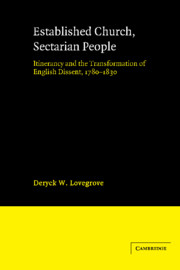 Established Church, Sectarian People
Established Church, Sectarian People Book contents
- Frontmatter
- Contents
- List of figures
- Preface
- Acknowledgements
- List of abbreviations
- 1 The Established Church and English Separatism
- 2 Itinerancy and Dissent
- 3 Preachers and sponsors
- 4 The academic leaven
- 5 Organization and infrastructure
- 6 Support and opposition
- 7 Criticism and legality
- 8 Developments and trends
- Conclusion
- Appendix A Journal of T[homas] Wastfield, June 1797–April 1798
- Appendix B Organizations active in itinerant evangelism
- Appendix C Baptismal statistics
- Notes
- Bibliography
- Index
- Frontmatter
- Contents
- List of figures
- Preface
- Acknowledgements
- List of abbreviations
- 1 The Established Church and English Separatism
- 2 Itinerancy and Dissent
- 3 Preachers and sponsors
- 4 The academic leaven
- 5 Organization and infrastructure
- 6 Support and opposition
- 7 Criticism and legality
- 8 Developments and trends
- Conclusion
- Appendix A Journal of T[homas] Wastfield, June 1797–April 1798
- Appendix B Organizations active in itinerant evangelism
- Appendix C Baptismal statistics
- Notes
- Bibliography
- Index
Summary
Although formal categories may be of limited value in an investigation of the dynamic character of early itinerant evangelism, the immediacy and individualism associated with that phenomenon must not be allowed to obscure the underlying developments. Changes in dissenting Protestantism were taking place which were eventually to prompt no less a personage than Lord Sidmouth to issue a warning of dire consequences for the religious life of the nation. Despite the unpromising theological legacy of strict Calvinism, the traditional concept of the settled pastorate and the customary association of itinerancy with the less inhibited traditions of Methodism, village preaching came during the late 1790s to occupy a prominent place both in English Dissent and in the life of the nation at large. It was a development which alarmed parliamentarians and High Churchmen alike and which provoked considerable internal opposition. The remains of mid-century Calvinist introspection combined with the tradition of congregational isolation and a static view of the ministry to create in conservative Dissenting minds, such as that of Walter Wilson, a deep distaste for itinerancy. From this traditional viewpoint the practice was scarcely less disruptive and unpalatable than it was to those who with impotent rage defended the privileges of the parochial Establishment. Yet, however great the shock to contemporary minds, this ‘methodistical’ practice had by 1810 spread to every English county, fracturing attitudes, values, beliefs and structures.
- Type
- Chapter
- Information
- Established Church, Sectarian PeopleItinerancy and the Transformation of English Dissent, 1780–1830, pp. 162 - 165Publisher: Cambridge University PressPrint publication year: 1988
